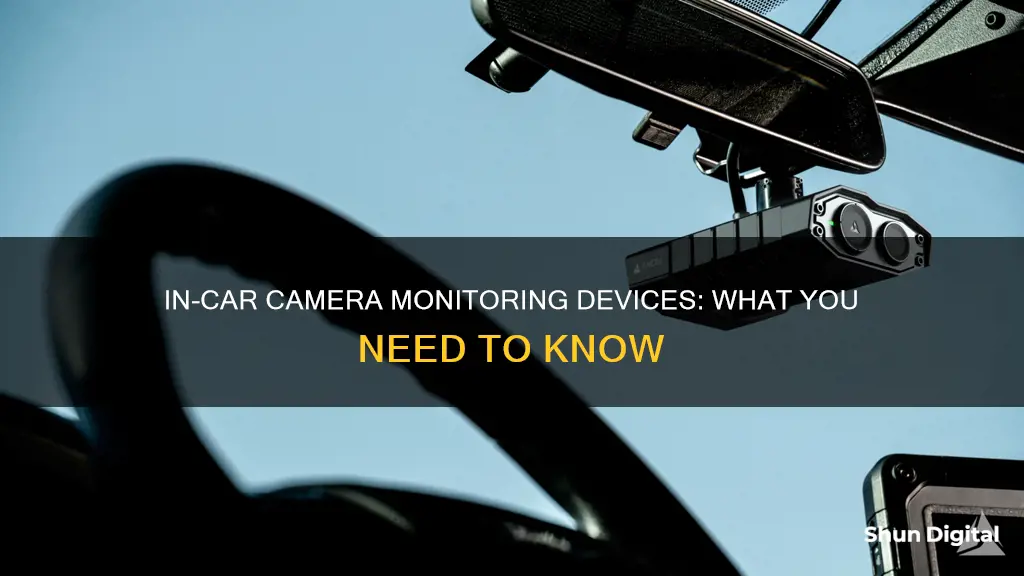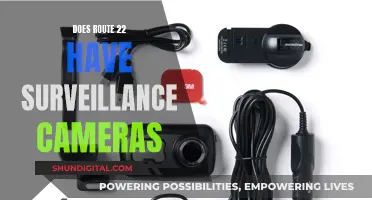
In-car camera monitoring devices are designed to enhance driver and passenger safety and comfort. They are usually dual-facing cameras that record both the interior and exterior of a vehicle. These cameras can monitor a range of parameters, including driver distraction and drowsiness, occupant health, and even a baby left in the back seat. In-car cameras can also be used for security purposes, such as detecting break-ins or capturing incidents of vandalism when the car is parked. While these devices raise privacy concerns, they have the potential to make driving safer and more comfortable.
| Characteristics | Values |
|---|---|
| Purpose | To enhance driver and passenger comfort and safety |
| Camera features | Wide field of view, night vision, motion detection, adjustable sensitivity |
| Camera resolution | 2.5 Mpx to 5 Mpx |
| Field of view | 190° to 200° |
| Lighting | Illumination via LEDs |
| Algorithms | State-of-the-art computer vision algorithms for body tracking and occupant classification |
| Data storage | Stores data locally on the device |
| Data retrieval | Data can be retrieved remotely via LTE connectivity |
| Alerts | Sends real-time alerts to the user's phone or tablet when a disturbance is detected |
| Two-way communication | Allows two-way talk between the driver and a remote user |
| Privacy | Includes a privacy shutter to disable the interior camera and audio recording |
What You'll Learn

Driver and passenger safety
In-car camera monitoring devices are designed to enhance driver and passenger safety and comfort. They are usually part of a broader in-vehicle monitoring system (IMS) or driver monitoring system (DMS) that uses artificial intelligence to track and analyse the behaviour of the driver and other occupants. These systems can also monitor the interior cabin and cargo areas of the vehicle.
In-car cameras are designed to reduce driver distraction and drowsiness, and can also capture vital signs, detect occupants' health and emotional states, and even sense a child's respiration in a rearward-facing car seat. They can also be used to adjust vehicle settings for different drivers, such as seat and side-mirror positions.
In-car cameras are increasingly being used to support hands-free automated driving and advanced driver-assistance systems (ADAS). These systems can include adaptive cruise control, forward collision warning, automatic emergency braking, lane-keeping assistance, blind-spot warning, and pedestrian detection.
In-car camera monitoring devices can also be used to detect unsafe behaviours such as speeding, harsh braking, and distracted driving. This information can be used to coach drivers and improve safe driving behaviours. In-car cameras can also provide valuable evidence in the event of an accident or insurance claim.
Overall, in-car camera monitoring devices have been shown to increase driver and passenger safety, reduce accidents, and lower costs for commercial fleets and individual drivers. They provide an extra layer of protection and peace of mind for drivers and passengers, ensuring a safer and more comfortable driving experience.
Exploring VR Mode in Cameras: An Immersive Experience
You may want to see also

Driver and passenger comfort
In-car cameras, also known as driver monitoring systems (DMS), have been added to vehicles to increase driver and passenger comfort and safety. DMS first started appearing in luxury vehicles almost two decades ago and are now becoming more commonplace. In fact, they will soon be mandatory in Europe.
DMS can help with a range of issues, from driver distraction and drowsiness to recognising individual drivers and adjusting vehicle settings for each. DMS can also support hands-free automated driving and activate various vehicle features. For example, BMW's new Highway Assist with automatic lane-changing is activated by the driver looking at the side-view mirror for two or three seconds.
DMS can also monitor the health of the driver and passengers. For example, DMS can detect a baby that has been left in the back seat or if someone has gotten sick in the car. It can also monitor the driver's vital signs, such as blood pressure and pulse, and use galvanic skin response to better understand the driver's emotional state.
DMS can also be used for fun. In China, for example, in-car selfies are popular. Some cars have a button on the steering wheel that takes a selfie of what's going on in the cabin and sends it to a WeChat feed.
How Oregon Handles Camera-Based Traffic Tickets
You may want to see also

Driver distraction and drowsiness
Drowsiness refers to sleepiness, often in inappropriate situations. Although the state of drowsiness may only last for a few minutes, its consequences can be disastrous. The reason for entering such a state is usually attributed to fatigue, which diminishes attention and alertness levels. Drowsiness may happen either by driving for long distances without enough sleep or driving at a time when the driver would typically be asleep. In such cases, the main problem is the drowsy driver’s lack of concentration, resulting in a delayed response to any event on the road.
Drowsy drivers exhibit various signs, which include repeated yawning, frequent eye closure, and repeatedly departing street lanes. Driver drowsiness detection (DDD) techniques have been researched intensively in recent years. Researchers have proposed various measures to detect these drowsiness signs as early as possible, in order to avoid accidents. These measures can be divided into four main categories: image-based measures, biological-based measures, vehicle-based measures, and hybrid-based measures.
Image-based measures are obtained using a camera to analyze the driver’s movements and facial expressions. Biological-based measures relate to the driver’s bio-signals and can be recorded by placing special sensors on the driver’s body. Vehicle-based measures depend on monitoring the behaviour and movement of the vehicle. Hybrid-based measures use two or more of the previous measures.
In-car cameras can be used in conjunction with DDD techniques to monitor driver distraction and drowsiness and help prevent accidents.
Camero Car Sales: Which Country Leads the Global Market?
You may want to see also

Occupant health
In-car camera monitoring devices have evolved from tools to combat driver distraction and drowsiness to systems that can capture a range of data about the driver and other occupants. This includes tracking the size, weight, and vital signs of occupants, as well as detecting if a baby has been left in the back seat or if someone has gotten sick in the car.
The inclusion of in-vehicle monitoring systems (IMS) with interior cameras and Electronic Control Units (ECUs) enhances both driver and passenger comfort and safety. These systems can monitor the interior cabin, providing a comprehensive view regardless of lighting conditions, and use AI-based algorithms to detect and classify various parameters such as age, gender, and clothing level.
One of the key features of in-car camera monitoring devices related to occupant health is the detection of vital signs and body positions. This technology can identify if a person is assuming a sleeping position and trigger an alarm to keep them awake. Additionally, combining camera-based data with cabin sensing radar data can provide information about the sitting position of all vehicle occupants, enabling the optimization of passive safety systems such as seat belt reminders and automatic airbag suppression.
The health monitoring capabilities of these systems have the potential to evolve further. Jennifer Tisdale, CEO of cyber-security company GRIMM, suggests that it is not a far-fetched idea to imagine technology achieving medical diagnoses or, at the very least, medical alerts notifying passengers to obtain a medical exam. However, there are challenges to implementing more advanced health monitoring features, including consumer desire, cost, software complexity, regulatory approval, and potential liability in the event of a health problem being missed or a crash occurring.
Despite these challenges, in-car camera monitoring devices have the potential to revolutionize occupant health monitoring, providing early warnings of potential health risks and enhancing overall safety on the road.
Polaroid Cameras: Where Are They Manufactured?
You may want to see also

Privacy concerns
In-car camera monitoring devices are designed to enhance driver and passenger comfort and safety. They can be used to detect driver distraction and drowsiness, as well as monitor the health and emotional state of the driver and passengers. While these systems have the potential to improve safety, they also raise privacy concerns.
One of the main privacy concerns with in-car camera monitoring devices is the collection and storage of personal data. These devices can collect sensitive information such as vital signs, age, gender, and clothing level, and even the location of the vehicle. This data can be accessed and used by various organizations, including insurance companies, police, and regulators, raising concerns about data privacy and protection.
Another concern is the potential for misuse or unauthorized access to the data. In one example, Tesla employees shared sensitive images and videos recorded by customer cars, including footage of a child being hit by a car. While Tesla claims that camera recordings remain anonymous, former employees stated that they could determine the location of the recordings, potentially revealing personal information about the vehicle owner. This incident highlights the risk of data breaches and the potential for malicious actors to access and misuse personal information.
In addition, there are concerns about the transparency and consent surrounding in-car camera monitoring systems. Users may not be fully aware of the extent of data collection and how their information is being used. For example, some drivers may not realize that their faces are visible in the footage or that their data is being shared with third parties. This lack of transparency can lead to a loss of trust and concerns about data privacy.
To address these privacy concerns, some automakers have implemented closed-loop systems that use infrared technology instead of recording video footage. These systems detect the driver's eye movements and head position without capturing or storing images. Additionally, legislation such as the bill before the California State Senate aims to protect consumers by prohibiting certain uses of in-vehicle cameras and requiring affirmative written consent for transmitting video recordings.
As in-car camera monitoring technology becomes more advanced and prevalent, it is crucial to balance the benefits of enhanced safety and comfort with the need to protect the privacy and security of drivers and passengers. Strong regulations, transparent data practices, and the use of privacy-preserving technologies are essential to address these concerns and ensure that personal information remains secure and is used responsibly.
The Making of the First Kodak Camera
You may want to see also
Frequently asked questions
An in-car camera monitoring device is a system equipped with an interior camera connected to a processing Electronic Control Unit (ECU). It enhances driver and passenger comfort and safety by providing a comprehensive view of the cabin, regardless of lighting conditions.
The benefits of an in-car camera monitoring device include improved safety, comfort, and convenience for drivers and passengers. It can help with driver assistance, hands-free automated driving, and recognising different drivers to adjust vehicle settings.
In-car camera monitoring devices can detect and classify various parameters such as age, gender, clothing level, and vital signs like heart rate and breathing rate. They can also identify individual drivers and adjust vehicle settings accordingly.
In-car camera monitoring devices are typically connected to the vehicle's OBD-II port and powered by the car's battery. They use AI-based algorithms and advanced sensors to monitor the interior and exterior of the vehicle, providing a comprehensive view of the cabin and its occupants.
Yes, there are privacy concerns associated with in-car camera monitoring devices. Some people may find it intrusive to have a camera pointed at them while driving, and there are concerns about data privacy and the potential for misuse of recorded footage. It is important for manufacturers and users to address these concerns through features like privacy shutters and data protection measures.







